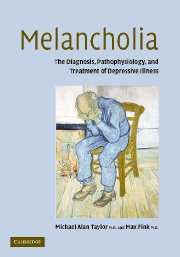Book contents
- Frontmatter
- Contents
- List of patient vignettes
- Preface
- Acknowledgments
- 1 Melancholia: a conceptual history
- 2 Melancholia defined
- 3 Defining melancholia by psychopathology
- 4 Defining melancholia: laboratory tests
- 5 Examination for melancholia
- 6 The differential diagnosis of melancholia
- 7 Suicide in melancholia
- 8 Electroconvulsive therapy for melancholia
- 9 Achieving effective ECT
- 10 The validity of the pharmacotherapy literature in melancholia
- 11 Basic pharmacotherapy for melancholic patients
- 12 Pharmacotherapy for melancholic patients in complicating circumstances
- 13 Proposed treatments for melancholia
- 14 The pathophysiology of melancholia
- 15 Future directions
- References
- Index
14 - The pathophysiology of melancholia
Published online by Cambridge University Press: 14 August 2009
- Frontmatter
- Contents
- List of patient vignettes
- Preface
- Acknowledgments
- 1 Melancholia: a conceptual history
- 2 Melancholia defined
- 3 Defining melancholia by psychopathology
- 4 Defining melancholia: laboratory tests
- 5 Examination for melancholia
- 6 The differential diagnosis of melancholia
- 7 Suicide in melancholia
- 8 Electroconvulsive therapy for melancholia
- 9 Achieving effective ECT
- 10 The validity of the pharmacotherapy literature in melancholia
- 11 Basic pharmacotherapy for melancholic patients
- 12 Pharmacotherapy for melancholic patients in complicating circumstances
- 13 Proposed treatments for melancholia
- 14 The pathophysiology of melancholia
- 15 Future directions
- References
- Index
Summary
I am gall, I am heartburn. God's most deep decree
Bitter would have me taste: my taste was me;
Bones built in me, flesh filled, blood brimmed the curse.
Self yeast of spirit a dull dough sours. I see
The lost are like this, and their scourge to be
As I am mine, their sweating selves; but worse
The biological components of depressive mood disorders are the theme of thousands of articles. Despite recognition that mood disorders are clinically and physiologically heterogeneous, few studies assess the biology of different forms of depressive illness. Our knowledge about melancholia is therefore limited, and is based largely on interpolation from hospital samples or patients identified as “severely depressed,” the groups most likely to include an abundance of melancholic patients. This chapter examines the neurobiology of melancholia. The association of melancholia with vegetative, psychomotor, and mood disturbances that result from the characteristic hypothalamic–pituitary–adrenal (HPA) axis dysfunction are the basis for the clinical features of melancholia. Their usefulness as diagnostic criteria is discussed in Chapter 4. Biological studies picture a mood disorder as an abnormal physiologic stress response. The neurochemical, electrophysiologic, and cognitive deviations are considered secondary to an abnormal stress response. Melancholic patients also demonstrate abnormal brain metabolism and structure that worsen with increasing numbers of episodes. Most abnormalities, however, resolve with proper treatment. When prolonged, the risk increases for future episodes of the illness.
A genetic predisposition for melancholia has been sought in genomic mapping.
- Type
- Chapter
- Information
- MelancholiaThe Diagnosis, Pathophysiology and Treatment of Depressive Illness, pp. 298 - 345Publisher: Cambridge University PressPrint publication year: 2006

